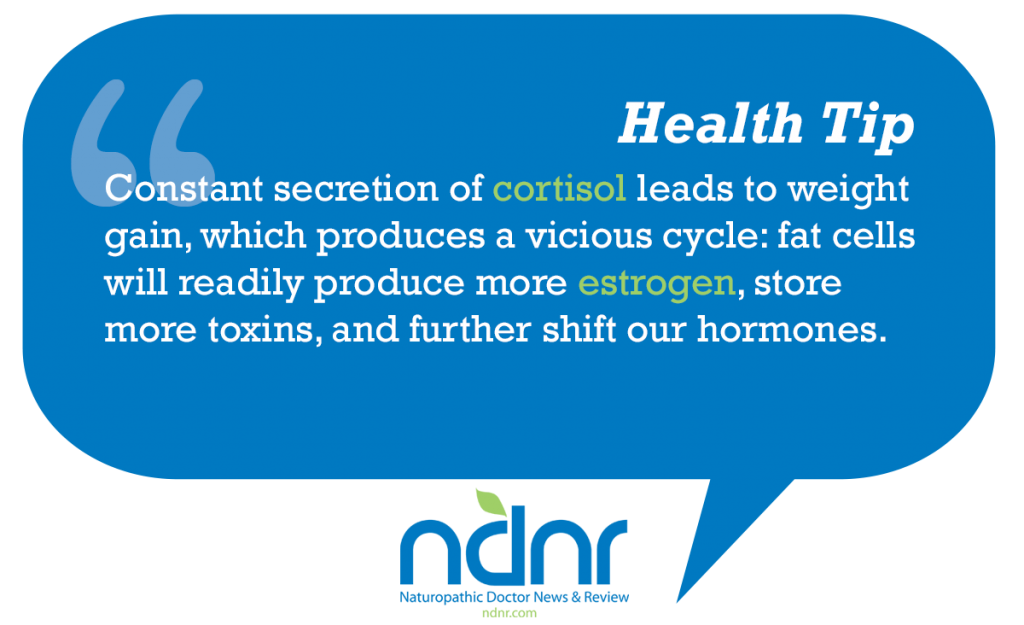Serena Goldstein, ND
The universe is a rhythm – we follow a clock and calendar, which for many of us means looking at a touch-screen device instead of the sun. Our bodies are also inherently rhythmic. Think of a plane ride that crosses time zones, causing us to experience jet lag. We depend on multiple rhythms in organs – not just the master clock in the brain, but also the liver, pancreas, and others – to stay in sync, because disarray can lead to obesity, diabetes, depression, or other complex disorders.1 Rhythms can also help preserve energy and our stress response, since with proper rhythmicity everything is functioning properly, without surprises. Humans are adaptable to shifts in their lives and can develop a new way to survive, as demonstrated by shift workers. However, they also have a much higher risk of developing the aforementioned complex conditions. Organ dysfunction can lead to hormone dysfunction, and vice versa, and all are affected by a combination of interrelated elements that should ideally be addressed with multiple methods of healing, and based on the root cause of disease.
We currently reside in a world that has made it more difficult to achieve the same level of health we may have experienced in previous decades. Environmental toxins, harmful plastics and other xenobiotics, and foods riddled with chemicals contribute to stress, leading the body to work overtime to maintain its appropriate function. Consider the countless reports of how chronic disease did not exist in many developed or developing nations until fast food and other products from the United States were introduced. The era of the industrial revolution in the 1950s rendered our food and environment (eg, more cars, transportation, building) quite different than the foundation of health our grandparents experienced. As a result, we now may live longer, but are sicker.
Rhythm Disruptors
Hormonal birth control was developed as a solution for sexually active women who did not want to get pregnant. Yet, somehow, it also became a treatment for women who experience subjectively bad acne, irregular menstrual periods, and PMS. If their conditions improved with birth control, then they were assumed to have a hormonal component as the root cause. We can certainly palliate, defined by Webster’s dictionary as “to reduce the violence of (a disease); also: to ease (symptoms) without curing the underlying disease.” However, addressing multiple etiologies to reveal the underlying cause will be these patients’ best therapy, as it also prevents a wide range of other conditions that could have made their appearance at another time in their lives.
Our gut bacteria are constantly being altered by our environment and genetics, and now research has shown the gut microbiome to be directly implicated in a diverse number of pathological states, such as obesity, autism, inflammatory bowel disease (IBD), and circulatory conditions.2 It can also influence drug metabolism and toxicity, availability of calories in the diet, immune health, and post-surgery recovery.2 Mucosal damage in the gut wall reduces the likelihood of receiving appropriate amounts of nutrients to make proteins and cholesterol-based hormones, while proteins that seep through compromised tight junctions may contribute to a variety of autoimmune conditions. Additionally, our gut bacteria may affect our estrogen levels by converting foreign components (eg, polycyclic aromatic hydrocarbons, pyrene, naphthalene) into structures that exhibit estrogen-like activity more potent than our own estrogen production in the liver.3 Furthermore, intestinal bacteria (usually pathogenic) that contains beta-glucuronidase can keep estrogen in circulation by uncoupling its bond with glucuronic acid in the large intestine.4
Estrogen has been a hot topic for decades, whether in terms of its link to certain cancers (eg, breast cancer in women, prostate cancer in men) and other conditions, discussions of hormone replacement therapy (HRT) or the best type of birth control, or its relationship to certain foods (eg, soy). For birth control and HRT, we’ve seen combinations of estrogen and progesterone, solely estrogen, solely progesterone, and single- or combination hormones in synthetic versions as treatment options. Estrogen also has a complex interaction with our central nervous system, enhancing the activity of gamma-aminobutyric acid (GABA) and serotonin, decreasing monoamine oxidase (MAO) activity, and acting as a cholinergic agonist.3 Women have a 1.5-3-times higher prevalence of major depressive disorder compared to men, and the presence of fluctuating, or low, estrogen levels places them at greater risk for developing depression or other affective disorders.5 Whether estrogen is showing an absolute elevation, or the other hormones are on the low end of normal or below normal, women can start by removing any substance from the home or diet that may contain hormones or hormone-disrupting chemicals.
Stress can result from negative or depressive thoughts, fear or anxiety, or obsessive rumination. During acute stress, a brief spike in cortisol can suppress metabolism, digestion, and reproductive function, in order to divert blood flow and energy to “fight or flight.” However, ongoing acute stress becomes chronic. Constant secretion of cortisol leads to symptoms such as weight gain, which produces a vicious cycle: fat cells will readily produce more estrogen, store more toxins, and further shift our hormones. Physiologically, increased cortisol blocks conversion of T4 (inactive thyroid hormone) to T3 (active thyroid hormone), instead shunting T4 into reverse T3 (rT3), another inactive metabolite. Elevated cortisol (from endogenous and exogenous sources of stress) suppresses thyroid-stimulating hormone (TSH), which stimulates the release of T3 and, to a greater extent, T4.6
Psychologically, if we don’t like the way we look or our clothes don’t fit right, for example, this cycle of negative thoughts can perpetuate our stress response and chronic cortisol output. Sugar and carbohydrates may temporarily suppress negative emotions and help us feel “full,” yet potentially lead to blood sugar imbalances, stress on the system, and additional physiological concerns to address. Furthermore, as stress disrupts gut function, the production of serotonin and melatonin (responsible for good mood and sleep, respectively) may be compromised, thereby causing difficulty in achieving positive thoughts and healing poor sleep. Consider a past trauma or life-altering experience as an underlying chronic stress when working with patients. Examples might include a patient admitting to bacterial vaginosis whenever she’s with a certain partner, or chest pain with the memory of a past love (when pathology has been ruled out), or thyroid symptoms beginning at a time when she was at a loss for self-expression.
The Journey of Continuous Healing
We can remove toxic products and resolve food intolerances, check for genetic mutations, and prescribe supplements that promote a more balanced system, yet educating our patients about how the body is widely connected can empower them, as well as improve compliance with our treatment plans. I’ve noticed this interplay most commonly in women in their late 20s to 30s, and sometimes 40s, who may seek out care yet hope for a “quick fix” while diagnoses keep mounting. Natural medicine provides many therapies that appropriately address the underlying cause while concurrently removing obstacles to cure. Rhythm restoration may not be immediate, as these conditions have etiologies often present since before they were born. However, at some point the focus will shift past healing into preventative care and the ability to live a long, healthy life.
 Serena Goldstein, ND, is a naturopathic doctor in New York City who specializes in hormone imbalances, stress, weight loss, and body image concerns, and utilizes natural therapies such as homeopathy, nutrition, botanical medicine, and biotherapeutic drainage to address the underlying cause of disease. She graduated cum laude with a double major in psychology and biology from the Barrett Honors College at Arizona State University, and received her naturopathic degree from National College of Natural Medicine in Portland, Oregon. Dr Serena also lectures with other professionals, writes for notable health publications, and lends her expertise to fellow doctors at NYU-Hospital Toxicology Center.
Serena Goldstein, ND, is a naturopathic doctor in New York City who specializes in hormone imbalances, stress, weight loss, and body image concerns, and utilizes natural therapies such as homeopathy, nutrition, botanical medicine, and biotherapeutic drainage to address the underlying cause of disease. She graduated cum laude with a double major in psychology and biology from the Barrett Honors College at Arizona State University, and received her naturopathic degree from National College of Natural Medicine in Portland, Oregon. Dr Serena also lectures with other professionals, writes for notable health publications, and lends her expertise to fellow doctors at NYU-Hospital Toxicology Center.
References
- Summa KC, Turek FW. The Clocks within Us. Scientific American. 2015;312(2):50-55.
- Kinross JM, Darzi AW, Nicholson JK. Gut Microbiome-host interactions in health and disease. Genome Med. 2011;3(3):14.
- Betts KS. A study in balance: how microbiomes are changing the shape of environmental health. Environ Health Perspect. 2011;119(8):a340-a346.
- Hall DC. Nutritional influences on estrogen metabolism. Applied Nutritional Science Reports. 2011. Advanced Nutrition Publications, Inc. Available at: http://cabeca.pagedragon.com/media/sites/36/files/NutrInfluencesEstrogen.pdf. Accessed November 1, 2015.
- Halbreich U, Kahn LS. Role of estrogen in the aetiology and treatment of mood disorders. CNS Drugs. 2001;15(10):797-817.
- Walter KN, Corwin EJ, Ulbrecht J, et al. Elevated thyroid stimulating hormone is associated with elevated cortisol in healthy young men and women. Thyroid Res. 2012;5(1):13.


